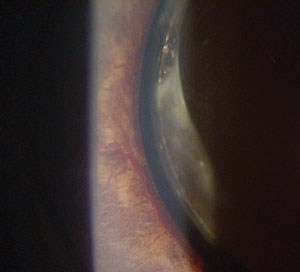 |
| While most patients with glaucoma benefit from anti-VEGF therapy, others—especially those with an IOP above 35mm Hg—may still require surgical treatment or lose their vision entirely. Photo: Lee Peplinski, OD. Click image to enlarge. |
In combination with drop therapy, anti-VEGF injections can sometimes help to prevent vision loss in patients with neovascular glaucoma. At the same time, this treatment method is also known to increase intraocular pressure (IOP) and in some cases can even cause angle narrowing. Researchers recently identified several clinically relevant thresholds that appeared to predict the need for glaucoma surgery or blindness in neovascular glaucoma patients treated with anti-VEGF.
Included in the retrospective cohort study were 301 eyes of 278 patients with neovascular glaucoma treated with anti-VEGF injections at a large retina subspecialty practice. Patients had no history of glaucoma surgery. Despite treatment, the researchers found that nearly a third (31%) of eyes required glaucoma surgery, and 20% progressed to no light perception vision. The following factors put patients at a higher risk of glaucoma surgery or blindness regardless of anti-VEGF therapy: IOP >35mm Hg, two or more topical glaucoma medications, vision worse than 20/100, proliferative diabetic retinopathy, eye pain or discomfort and new patient status at the time of neovascular glaucoma diagnosis.
“An IOP criterion of >35mm Hg at initial presentation was determined by utilizing the ROC curve to have the highest specificity and sensitivity for predicting uncontrolled glaucoma,” the researchers explained in their paper on the findings, published in Retina. Additionally, they reported, “Median time to uncontrolled glaucoma decreased from 826 days in eyes receiving zero and one topical medication to 247 days in eyes receiving two or more topical medications.”
Conversely, visual acuity of 20/100 or better seemed to have a protective effect against uncontrolled glaucoma. In a multivariable logistic regression model, the number of intravitreal injections (odds ratio: 0.84) and prior panretinal photocoagulation (odds ratio: 0.41) had a protective association with visual acuity change at six months. However, in a subgroup analysis of patients without media opacity, panretinal photocoagulation didn’t have a significant effect on surgery or blindness risk post-treatment with anti-VEGF.
“These patients appear to be at the highest risk for adverse outcomes, and strong consideration should be made to refer them expeditiously to a glaucoma specialist for management,” the researchers concluded in their paper.
Massenzio E, Xu D, Abishek R. Risk factors for surgery or blindness in neovascular glaucoma eyes treated with anti-VEGF injections by a retina specialist. Retina. March 9, 2023. [Epub ahead of print]. |

